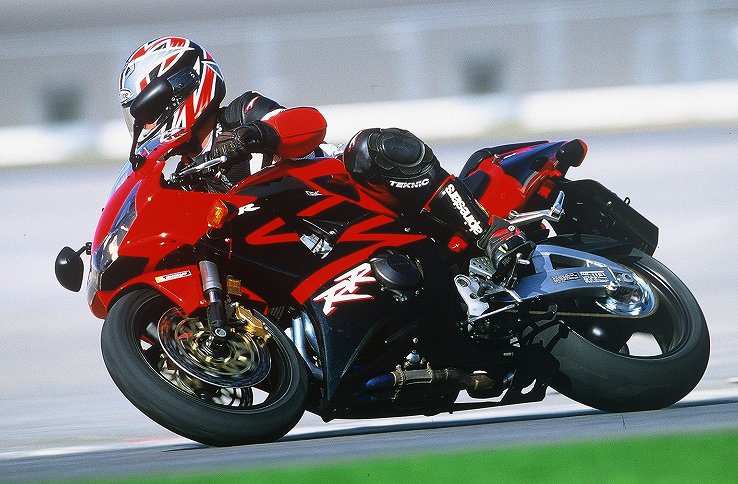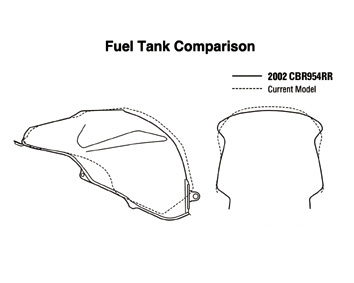
We have previously written about the technical changes Honda made to last year’s CBR929RR with the introduction of its 954RR this year. We had a chance to ride the new bike at Las Vegas Motor Speedway, and briefly wrote about our experience on January 16, 2002. This is a more thorough discussion of our day at the race track with Honda’s new open-class sport bike.
With its larger displacement and higher compression engine, Honda sought to maintain the light, nimble handling of the 929 (and even improve on that handling) while boosting torque and horsepower to compete more directly with Yamaha’s R1 and Suzuki’s GSX-R1000. Honda deliberately chose not to go all the way to 1000 cc, however, in order to combine what it saw as the best of both worlds, i.e., big horsepower and light weight.
Although you should go back and read our introduction and technical analysis of the 954RR, I will mention the points that stood out in Honda’s technical presentation the evening before we rode the bikes.
The 954RR is the direct descendent of engineer Tadao Baba’s revolutionary CBR900RR, introduced in 1993. That model combined the weight and size of a 600 with the engine performance of an open-class machine. It was a revolutionary model in the sport bike class. Baba’s twin goals of ultra lightweight (“light is right”) and all-around ability, never changed. Indeed, the 2002 CBR954RR is the lightest open-class sport bike. It has a dry weight of 370 pounds — identical to Honda’s CBR600F4i model. It also has a slightly less radical seating position this year, with the bars 10 mm closer to the rider (the result of a shorter gas tank) and slightly better wind protection (an optional, taller windshield is available, as well).
Power and torque at the crank are 154 at 11,250 rpm and 77.4 pound feet at 9,500 rpm, respectively. The engine features not only increased displacement, but larger throttle bodies (now 42 mm) and the lightest piston in its class. Cam timing has been changed, and a titanium muffler has been added for lighter weight.
The geometry of the 954RR’s chassis is unchanged from last year, but stiffness, both torsionally and laterally, has been adjusted by Honda to improve handling. The steering head casting thickness, for instance, has been increased, and, together with new tapered roller steering-head bearings, the 954RR provides even more precise steering feel (something I agree with after riding the bike).

The new swingarm is an attractive and interesting part of the chassis. The right-side of the swingarm is press formed and is connected to a left-side extrusion. The new swingarm is larger, yet significantly lighter due to reduced wall thickness. From the right side of the bike, the swingarm looks like a work of art.
The revisions to the 929’s brakes include the new, steel pistons with Teflon-coated seals, and fluid pressure is increased by 10% (presumably, due to master cylinder changes).
Detail changes to save weight include a lighter shock spring, LED-type tail light (which is extremely bright), and aluminum foot peg brackets (formerly steel). Of course, the body work and head light design are also new.
I rode the new 954RR in four, separate twenty-minute sessions on the same track used by the AMA Superbike series several years ago, combining an extensive infield course with use of the high banking as the main, fast straightaway section. I rode the same track for one twenty-minute session on last year’s 929RR, for comparison purposes.
The 954RR has much greater low-end and mid-range power than the 929RR. This power characteristic makes the bike much more flexible — a choice of two gears while exiting corners is typical. The bike pulls smoothly from as low as 3,000 rpm, and hard from as low as 5,000 rpm. The useful powerband is huge, with peak horsepower arriving above 11,000 rpm. This factor alone will make the 954RR a much more entertaining street bike.
It was difficult to isolate the causes for the new front-end feel given by the 954RR, because the new bike features new tires from Michelin (Pilot Race 2). Part of the enhanced feel has to come from the chassis changes, including the new steering-head bearings and the stiffer, thicker steering-head casting. While the 929RR provided good front-end feedback, the 954RR provides phenomenal feedback from the front tire (noticeably better than the 929RR). As a result, I found myself trail braking into corners (something I am not normally comfortable with) and trusting the front-end to stick. You can even feel track surface changes quite accurately through the bars as you ride the 954RR, and, particularly, while hard on the brakes.

The shorter reach to the bars, and the re-shaped gas tank on the 954RR make the new bike significantly more comfortable to ride than the 929RR. Being closer to the front end (with the shorter gas tank) places more of the rider’s weight onto the front contact patch, and must also contribute to the tremendous feedback the rider receives from the front end of the bike. The gas tank shape, including the knee cut-outs, just seem to work better than last year’s design, and allow the rider to move more easily from side to side while transitioning through turns.
Ergonomically, the bike is otherwise very much like the 929RR. For a sport bike, it provides a reasonably comfortable mount for street use, while being aggressive enough to feel right on the race track.
No complaints about the clutch or transmission. Like many Honda transmissions, you do feel a “clunk” on most gear changes, but gear changes are positive and low effort, nonetheless. Gear spacing felt about right, but the powerband is so wide it would be hard for Honda to screw this up.
Honda wanted the 954RR to change directions even easier than the 929RR, and feel even more like a 600 in this respect. I don’t know that I could tell much of a difference, however, in part, because the 929RR is already the most nimble open-class machine. What I did notice was a more balanced feeling from the 954RR. Somehow, Honda has taken a chassis with virtually identical geometry and made it feel different in this sense. Although both the 929 and the 954 felt neutral on the track, and handled extremely well, the 954 simply has a more cohesive feel to it. It is as if the 954RR tracks slightly better through corners. Unfortunately, although I tried to ride the 929 and the 954 back-to-back in the same session, I was unable to do so. Due to another magazine editor’s crash, all of the journalists were kept off the track for an extended period of time immediately after I rode the 929. Suffice it to say, I came away believing the 954 handles significantly better than the already-excellent 929 — with a more balanced feel, better feedback from both tires, and much improved braking feel (and power).
Despite riding the 954RR on a race track, and not on the street, I nevertheless believe the 954RR will be a much improved street bike. The significant boost in low-end and mid-range power, as well as the more balanced feel and improved ergonomics, should result in a big step forward from the 929RR.
The CBR954RR will be available in dealers in the United States next month at an MSRP of $10,599.
By the way, as a side note, I had an extensive discussion with engineer Tadao Baba at the race track while a different group of journalists was riding. I asked him, specifically, why the 954RR had a “pivotless frame” where the main frame spars extending from the steering head do not join the swingarm pivot. I wanted to know why the 954RR had this feature while Honda’s dedicated superbike (the RC51, or the SP-2 in Europe) had a traditional frame that carried the spars all the way to the swingarm pivot. While discussing this subject with me, he created an original drawing that he gave to me — showing technical differences between various models and design changes that made the pivotless feature appropriate for both the 929RR and the 954RR. I will scan this drawing and create a link here (check back later).





